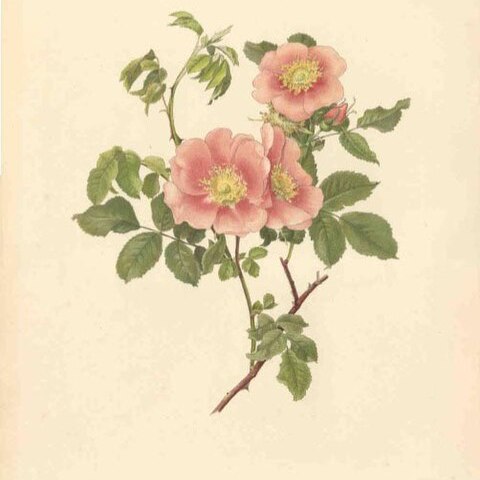Shrubs 1–2 m tall. Branchlets terete, straight or slightly curved, glabrous; prickles in pairs below leaves or scattered, yellowish, strongly hooked, to 1.5 cm, flat, gradually tapering to broad base, often densely intermixed with small prickles and bristles. Leaves including petiole 4.5–10 cm; stipules mostly adnate to petiole, free parts ovate, glabrous, auriculate, margin glandular serrate, apex acute; rachis and petiole sparsely prickly, glandular-pubescent, puberulous; leaflets 7–9, elliptic, oblong, or ovate, rarely obovate, ca. 1.5 × 0.8–2 cm, glabrous or pubescent, with prominent midvein and lateral veins, base subrounded or broadly cuneate, margin simply serrate, rarely doubly serrate, apex acute or rounded-obtuse. Flowers often 3–6 in corymb, sometimes solitary, ca. 3 cm in diam.; pedicel 1–1.8(–3) cm, glandular; bracts ovate, pubescent, glandular hispid, apex acuminate. Hypanthium oblong or ovoid, glabrous, rarely glandular hispid. Sepals 5, ovate-lanceolate, leaflike, abaxially sparsely pubescent and glandular hispid, adaxially densely pubescent, margin entire. Petals 5, white or pink, obovate, apex erose. Styles free, much shorter than stamens, densely villous. Hip red, oblong or ovoid, 1–1.8 cm in diam, glabrous, often shiny, apex with a short neck and persistent, erect sepals. Fl. Jun–Aug, fr. Aug–Sep. 2n = 14*.
More
A shrub. It grows 2-2.4 m high and spreads 1.5-3 m wide. The stems arch over. They have bristles and a few large thorns which curve backwards. The leaves are compound. There can be up to 9 leaflets. These can be 5 cm long. There are teeth along the edge. There are sometimes hairs underneath. The flowers are pale pink and in clusters of 1-6. They are 5 cm wide. The fruit are red hips 12 mm long.
Steppe meadows, forest edges and river banks. Populus forests, scrub, valleys, damp grassy places, river and stream sides; at elevations from 500-1,500 metres.
More
It is a temperate plant. In western China it grows near rivers between 500-1,500 m above sea level. It suits hardiness zones 5-9.
Can be grown by cuttings or seedlings. Seeds needs scarification.

